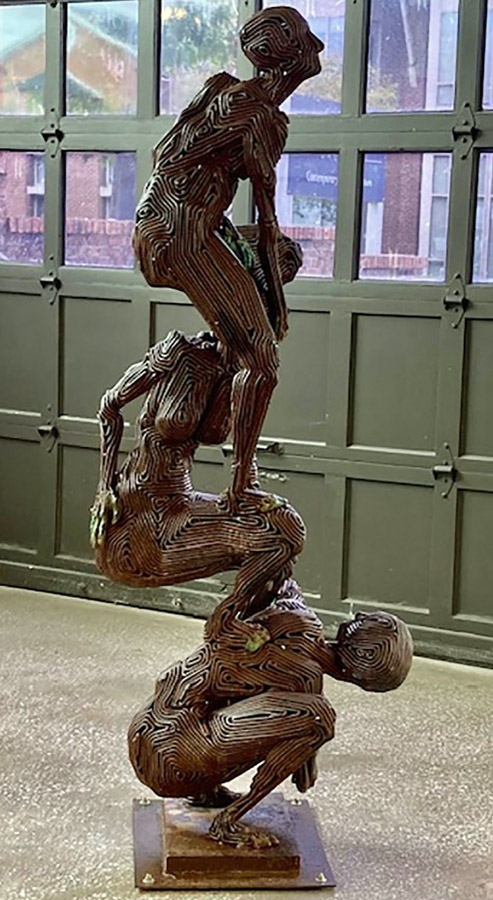North Carolina sculptor Aaron Alderman uses a technique he developed of drawing in space with round-stock steel.
Artist: Alderman grew up in Brevard, NC, and still calls it home.
After graduating from Brevard College, he went to work with his college sculpture professor, Tim Murray, as a teaching assistant. He also helped Murray produce a monumental aluminum sculpture titled “Mountain Rhythms” on the Brevard College campus.
Alderman also worked for J.T. Copper, a coppersmith, who produced high-end, hand-crafted architectural elements, mainly light fixtures and draw pulls.
“Both of these working experiences furthered my education and allowed me to develop the skills and craft I use today,” he said.
In the beginning: Alderman graduated from college in 1999, but it wasn’t until about 2004 that he began to develop the method he uses today.
Commissioned to make an elk sculpture, he had to figure out how to make a large, outdoor, public sculpture. Alderman took what he learned working with the coppersmith and applied that to steel.
Ever since then, he’s been developing this highly physical technique of drawing in space with round-stock steel.
Studio: In 2018, Alderman built his own 500-square-foot studio, located within minutes of his home in Brevard. The Black Box Studio, which he calls it, is a little black box of a metal building.
Art & materials: Figurative sculpture, mainly using round-stock steel. He works with 1/4-inch, 5/16-inch and 3/8-inch round stock, which all have different attributes. But he prefers the 5/16 for life-size figures, which are usually accented with handmade copper elements on the hands & feet.
Favorite or go-to tools: A small stick welder, torch, grinder with a cut-off wheel, hammer and some pliers and clamps. But his favorite tool is probably the oxy/acetylene torch.
“Every bend, curve, turn, in both the steel & copper, is made with the help of the torch,” said Alderman. “It’s the torch that transforms the cold, rigged material into soft organic forms.”
What’s popular: Life-size, abstracted figures ($12,000 to $14,000).
Other favorites: Lately, a large series of copper bird sculptures, using found-object pieces to make pedestals for the birds to perch on ($3,000 to $6,000).
Process:
- Begins with a length of round-stock steel, which has one end welded in place, usually starting at the feet.
- Then uses a torch to heat and bend the metal, translating a line from a sketch into a three-dimensional line of the figure.
- Repeats this process over and over again: tac weld, heat and bend, tac weld, heat and bend. By repeating lines up against one another, the form begins to take shape and the figure emerges.
- There is no substructure, the skin is the structure. Therefore, every line, every bend in each line, has to be thought out and carefully placed to create each sculpture.
- Copper accents are made in a similar fashion with a brazing rod melted over the copper lines to create a final element that looks like it has been cast.
Inspirations: Two main artists he has always admired are Egon Schiele and Jackson Pollock. He emulates their work in his own with: Schiele’s simple and few stylized lines that capture the figure, and Pollock’s random chaotic, mesmerizing drips.
Special or unusual commissions:
- Years ago, he created a series of life-sized horses made from horseshoes. While working on this series, he thought it would be compelling to create a bison made from railroad spikes to highlight the history between the bison, railroad and prairie.
- Almost 10 years later, Alderman got to make that happen with a public commission for Lowe Park in Marion, IA. He created a bison and four figures that are walking across the open prairie. The mane of the bison is made from railroad detritus and weighs almost a ton.
Recent awards/honors: Public shows in Springfield, MO. and North Charleston, SC.
Where to buy: volumesofsteel.weebly.com
Get social:
- Facebook: J. Aaron Alderman
- Instagram: @j.aaronalderman


















